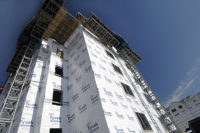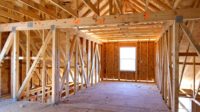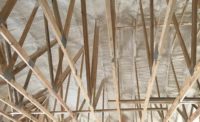
Figure 1. Typical Installation of Air & Water Barrier in a Framed Wall (Building Wrap installed over the exterior sheathing, behind exterior insulation board)
Air leakage is the unplanned, unpredictable and unintentional airflow across the building enclosure. This makes air flow control important for several reasons: to avoid air transported moisture and moisture damage, to reduce energy losses and to ensure occupant comfort and health. Air leakage control is achieved with continuous air barriers and it is regulated through energy codes.
Why Worry About Air Leakage?
Air leakage can impact energy efficiency, durability and indoor environmental quality. The direct impact of air leakage on building energy performance is the result of infiltration of unconditioned air or exfiltration of conditioned air, both requiring the HVAC mechanical system to compensate for the losses. Energy simulations have shown that reducing air leakage can result in over 40 percent HVAC energy savings in certain climates. The indirect impact of air leakage on thermal enclosure performance is the result of loss of insulation R value due to air movement and moisture transported by air currents. These effects are more difficult to quantify.
Figure 2. Typical Installation of Air & Water Barrier on CMU back-up wall (Fluid Applied Air Barrier installed on the exterior side of CMU, behind exterior insulation board)
Air leakage control is important for indoor environmental quality and occupant comfort. Unfortunately, the impact of an airtight building enclosure is often misunderstood. Misleading statements such as “the more air tight our buildings are, the more polluted they may be inside” are unfortunately still being used. In fact, the opposite is true: Reducing the uncontrolled air leakage can improve IEQ and occupant comfort.

Figure 3. (this picture and the next two) Treating of sheathing joints prior to FA application over exterior sheathing
Air Leakage Control
In order for air leakage to occur, there must be a driving force (air pressure difference across the building enclosure) and a pathway. The main sources of air pressure difference include wind pressure, mechanical pressure and stack effect. Unintended openings and discontinuities in the building enclosure are potential air leakage pathways. Since the air pressure difference cannot be eliminated, the strategy for air leakage control is to minimize the airflow pathways. This is achieved with a continuous air barrier, which is a combination of air barrier materials and accessories that help achieve a continuous plane of airtightness. In addition to their primary function of air leakage control, air barriers are also water barriers in that they protect against bulk water intrusion.There are three main types of air barriers: mechanically fastened, fluid applied and self-adhered membranes. Some common building materials such as OSB, closed-cell spray polyurethane foam insulation, and board insulation can be components of an air barrier system. However, achieving continuity and durability with these materials could be challenging. The choice of air barrier depends on the project type and location, wall design, installation preference, local expertise, technical support, etc.

Fluid applied air barriers are one- or two-component formulations in organic solvents or a water base and are applied on site by brush, spray or roller. The two-component formulations are mixed at the site prior to application, while single-component formulations do not require site mixing. The most common continuity accessories for FA barriers include self-adhesive mesh, flexible joint compound, flashing, caulks and sealants.

The FA air barrier performance is highly dependent on film thickness and continuity, both of which depend on contractor training and quality of workmanship. The film thickness must be checked during the application, using a thickness gauge as shown in Figure 4. The surface coverage for fluid-applied membranes varies with manufacturers, application technique and type of substrate. Many FA membranes require two-coat application to achieve proper thickness. Newer compositions with excellent coverage and single coat application are available. Some fluid applied membranes undergo shrinkage and cracking on curing. Newer compositions are available with superior elasticity, flexibility and extremely low shrinkage qualities.

Figure 4. (this picture and the next) Using thickness gages during fi eld application of FA membrane
Is there an ideal choice of air barrier for a particular project?
Each air barrier type has advantages and limitations, and some are best suited for a particular application than others. For example, mechanically fastened membranes are the most cost effective solution for light framed construction, even though other types can be used in this application. Fluid applied membranes are the best suited for concrete masonry walls, especially CMU with embedded ties, even though FA membranes are often used in other applications. Self-adhered membranes are perceived as providing limited self-sealing capabilities and are sometimes preferred.

Vapor permeability-a material’s ability to allow moisture vapor to pass through-is an important consideration when choosing an air barrier. Vapor permeable air barriers do not interfere with drying potential. They can be installed at any location in the building enclosure and have no climate specific limitations. By contrast, vapor impermeable air barriers can interfere with diffusion drying potential; their placement within the building enclosure is climate-specific and special consideration must be given in order to avoid vapor traps and persistent condensation within wall assemblies.

Detailing of interior corner for integration of building wraps with fl uid-applied air barriers
Recent Changes in Air Barrier Codes
Air barrier codes and standards include requirements for air barrier materials, assemblies or whole buildings. National Building Code of Canada, the first air barrier code in North America, has included an air barrier material requirement since the mid-90s. In 2001, Massachusetts became the first state in the U.S. to adopt an air barrier code which includes materials requirements similar to those of the NBC. Since then, many other states have adopted similar air barrier standards (Minnesota, New Hampshire, Georgia, Rhode Island, Oregon, Washington, etc.) and the list is growing. ASHRAE 90.1-2010, and ASHRAE 189.1 include a mandatory requirement for air barrier materials and air barrier assemblies. IECC 2012 will also mandate air barriers.Whole building airtightness is the ultimate goal of a continuous air barrier system. The first whole building airtightness measurement and verification standard has been introduced by the U.S. Army Corps of Engineers. USACE mandates that the building enclosure must be designed, constructed and tested to demonstrate that air leakage does not exceed a certain leakage rate (e.g. 0.25 cubic feet per minute per square feet–cfm/feet², at a pressure differential of 75 Pa). This is the first performance measurement and verification program for building enclosure air tightness implemented by a government agency in the United States. A similar program was recently introduced by the General Services Administration in January 2011. The International Green Construction Code now under development also includes a whole building airtightness requirement.





